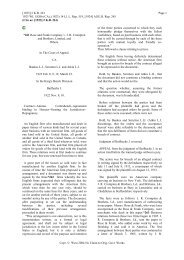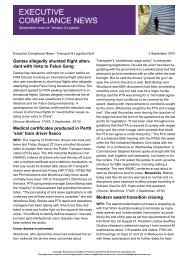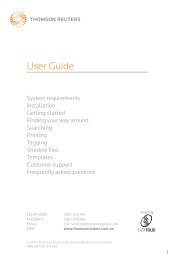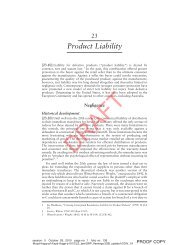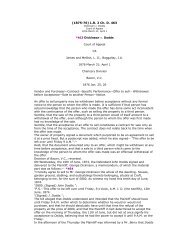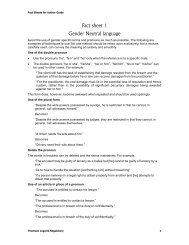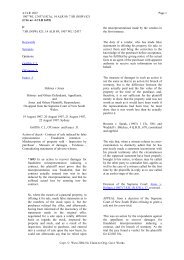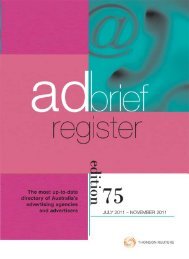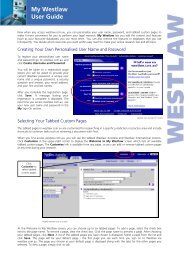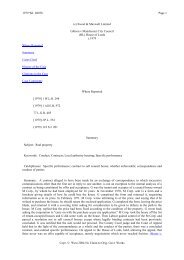Tesco v Constain - Thomson Reuters
Tesco v Constain - Thomson Reuters
Tesco v Constain - Thomson Reuters
Create successful ePaper yourself
Turn your PDF publications into a flip-book with our unique Google optimized e-Paper software.
2002 WL 347140 Page 252002 WL 347140 (QBD (T&CC)), [2002] EWHC 482(Publication page references are not available for this document.)agreement he may retract all or any of what hemight up to the point of retraction have agreed.This is important, for it means that in looking atnegotiation over a course of correspondence it isnot legitimate to suppose that what is agreed at onepoint in one context, should be treated as agreed ata later point in a different context. In my judgmentit is only if one can, on a fair reading of therelevant correspondence as a whole, construe thedocument which ultimately is relied on as the offeras incorporating by reference or by inferencematters agreed earlier in the negotiations, that theyare to be treated as included. Otherwise they are notto be treated as included. A conclusion that mattersconsidered earlier in negotiations are not to betreated as included by implication, if not expresslyreferred to, in the otherwise final offer could resultin the analysis that the supposed agreement was notan agreement. It would do so unless it appearedthat agreement on the matters not mentioned wasno longer required.Application of the law to the facts of the case76. In my judgment it is plain that the contractcontended for on behalf of HTA is not made out.The last document in the series of correspondencerelied on on behalf of HTA was the memorandumdated 17 November 1997 written by Mr. Springgayto Mr. Hunt. It was by acceptance of an offercontained, or recorded, in that document, if at all,that a contract was made between HTA and theDefendants. That memorandum began, Further tomy memo of 10 November, your subsequent fax of13 November and our discussion this afternoon, theConsortium will agree to the following revisions tothe heads of terms. It seems to me that thereference to the heads of terms in the context of thecorrespondence between the parties was a referenceto the letter dated 3 November 1997 written by Mr.Springgay to Mr. Hunt. Thus, in my judgment, forthe purposes of considering whether any, and, if so,what, offer was made to HTA which might havebeen capable of acceptance so as to give rise to abinding contract, one needs to read together theletter dated 3 November 1997, the memorandumdated 10 November 1997 written by Mr. Springgayto Mr. Hunt, and the memorandum dated 17November 1997. Looking at those documentstogether it is apparent, first, that although a designteam comprising Ralph Erskine, HTA, CT, BM andBBMK is identified, there is no indication in therelevant documents as to which of those entities isto do what in relation to the period after success inthe competition, if achieved, or, indeed, before thattime. A particular matter unresolved but arisingfrom the memorandum dated 10 November 1997was the production of a workplan showing therespective roles of Ralph Erskine and HTA. Thememorandum dated 17 November 1997 made itclear that such a workplan was still required. Thememorandum dated 10 November 1997 indicatedthat the Defendants were not themselves, or any ofthem, contemplating entering into any agreementwith HTA, but envisaged that a joint venturecompany would be formed which would, all beingwell, in the fullness of time enter into separateagreements with each member of the design team.The terms of any such agreements would, it wascontemplated, be based on the RIBA StandardForm of Agreement, but amended to reflect thisparticular project and its requirements. Whatamendments might be sought was not addressed,but I think that the requirements referred to musthave been those desired by the joint venturecompany to be established, rather than somethingobjectively justified. It was plain, however, thatsome further, formal agreement with each memberof the design team was contemplated. The questionof copyright was raised in the memorandum dated10 November 1997 and it was made clear that someprovision was required to enable the use by anotherarchitect, if one was brought in after Stage D, ofwork done prior to that. However, no specificprovision was suggested, nor was any provisionaccepted by HTA. In all the circumstances it isclear, in my judgment, that the memorandum dated17 November 1997 contained no offer specificenough to be capable of acceptance so as to giverise to a binding contract. That was in fact areflection of the fact that the parties, objectively,were still in negotiation, and had no thought ofentering into a binding agreement at that stage.What was under discussion were Heads of Terms,not in the sense, which is conceptually possible, ofa preliminary agreement to continue in operationuntil a later, fuller agreement had been made, but inthe sense of identifying the most important matterswhich would need to be addressed in negotiationsfor formal appointments. In other words, whatwas, objectively, under discussion was a sort ofagenda for future negotiations, albeit with anindication of what provision was likely to beincluded in respect of the significant matter ofremuneration.77. In my judgment what I have earlier in thisjudgment called Mr. Douglass bootstraps argumentdoes not avail the Claimants because theunderlying premise is false. The underlyingpremise is that the Developers and the DesignTeam intended to make a binding agreement inrelation to the sums to be paid in relation to thework of the Design Team in respect of Phase 2 ofthe competition. On the back of that premise Mr.Douglas seeks to haul up an agreement in relationto work on Phase 3 of the GMV project by thebootstraps of Phase 2. His submission was thatCopr. © West 2004 No Claim to Orig. Govt. Works



